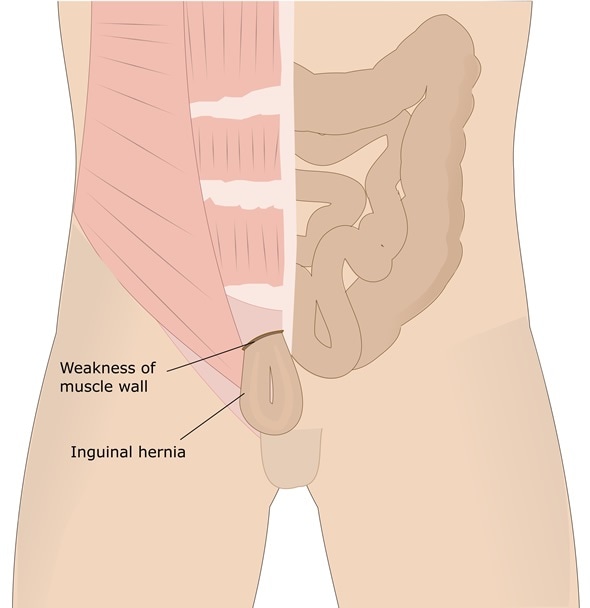An inguinal hernia is a lump in the groin region, caused by the protrusion of the abdominal cavity fat or intestine, along with its peritoneal covering, and associated fluid, through the abdominal wall at this location.
Causes
An inguinal hernia is due to the presence of weakness in the abdominal wall that is present, even at birth. This occurs because the muscles of the abdominal wall fail to close as they should.
The inguinal canal (in the groin) is formed by the joining of the various layers of the abdominal wall at the junction between the muscles of the abdomen and the thigh, in the groin region.
This area is especially vulnerable in baby boys, because the spermatic cord attached to the testis passes through the inguinal canal from one end to the other, leaving a potential opening at one end and a potential space around it.
When the peritoneum that closes off the opening fails to approximate properly, an inguinal hernia develops. 9 out of 10 babies with inguinal hernias are boys. Female babies are not at risk because their canals contain only the round ligament and do not offer any space for intra-abdominal contents to pass through.
In such a situation, the bulge appears or becomes larger when intra-abdominal pressure is increased, for example, when the baby strains at stools, coughs, sneezes or cries.

inguinal hernia - Image Copyright: ellepigrafica / Shutterstock
Types
An inguinal hernia may be of the direct or indirect type. Direct inguinal hernias are due to acquired weakness of the abdominal wall, which develops with injury or stress over time. These occur in males during adulthood. The abdominal contents press on the weak spot in the inguinal region to eventually enter the inguinal canal from the side.
Indirect inguinal hernias are more common than direct inguinal hernias. They occur in about 2-3% of male children but only 1% of female children. They are due to a descent of the abdominal peritoneum along the inguinal canal through an opening which is left open instead of closing as it should.
The abdominal contents eventually slide down along the peritoneum and form a hernia. Such children have a very high chance of having a hernia on the other side as well. Inguinal hernias may slide all the way into the scrotum.
Symptoms
Inguinal hernias produce symptoms or may remain symptomless for long periods of time depending on their size and the presence of other complications. These include:
- A bulge in the inguinal region which enlarges with straining or any other cause of an increase in the pressure inside the abdomen.
- The hernia may cause a burning or aching sensation, or a feeling of heaviness, especially when intra-abdominal pressure rises, which is reduced or absent during rest.
- Incarceration of a segment of bowel within the hernial sac producing pain, nausea, vomiting, and constipation. This is especially so if the sac is small or moderate, making it difficult for a bowel loop which is trapped to move out of the inguinal canal through the small orifice.
- Strangulated hernia is a condition in which the vascular supply to the intestine inside the hernial sac is cut off by the pressure of the constricting boundaries of the hernial opening, causing the intestine to become gangrenous if the pressure is not promptly relieved.
Diagnosis
An inguinal hernia is usually diagnosed by the typical swelling and other clinical features. Ultrasonography of the hernial mass is useful to confirm the presence of intestinal loops within the hernial sac.
Treatment
A hernia needs to be surgically repaired (called a herniorrhaphy) by excising the hernial sac after reducing the intestinal loop it contains, if any, back into the abdominal cavity, and closing off the opening or weak spot and strengthening the inguinal muscle wall. Both sides should be repaired as most children with an inguinal hernia will eventually develop a hernia on the other side as well.
References
Further Reading
Last Updated: Dec 30, 2022